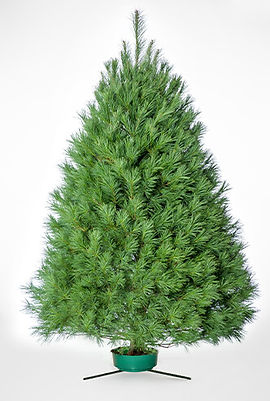
Tree Types
We’re often asked, “What’s the best Christmas tree?” As growers, we’ve learned there isn’t just one answer. Each variety has its own strengths and charm — and the right tree for you depends on what you love most. On this page, we’ve shared more about the different types we grow to help you find your favorite.
Fraser Fir

Lasts longer and looks better and holds heavier ornaments.
Color: dark blue-green Needles: excellent retention. 1/2-1 inch long, soft to touch, dark green on top and silvery white on bottom
Scent: excellent, pine
Typical shape: tall, narrower at bottom, more pocketed for ornaments placed into the tree
A native southern fir and very similar to Balsam fir. Some say it is a southern extension of the Balsam fir species and naturally grows at elevations above 5,000 feet. This fir has dark green needles, 1/2 to 1 inch long and ships well. The tree has excellent needle retention along with a nice scent. Fraser fir was named for Scot botanist John Fraser who explored the southern Appalachians in the late 1700's.
Douglas Fir
Lasts longer and looks better and holds heavier ornaments.
Color: light to medium green
Needles: excellent retention. 1-1-1/2 inch long, soft to touch, very green
Scent: excellent, pine
Typical shape: wider at bottom, more full throughout
Not a true fir but actually has its own unique classification. Unlike true firs the cones on Douglas fir hang downward. Douglas fir grows cone-shaped naturally, has 1 to 1-1/2 inch needles that are persistent and has a sweet scent when crushed. The Doug fir tree is shipped to and found in nearly every tree lot in the Unites States. The tree was named after David Douglas who studied the tree in the 1800's.

Concolor Fir

Good ornamental tree, citrus scent, unique coloring
Color: bluish green
Needles: good retention, 2-3 inch long,
Scent: excellent, citrus
Typical shape: medium to wide at bottom, more full throughout
One of the longest-needled firs and is sometimes mistaken for a pine. A significant portion of these Christmas trees are used in California: Concolor fir has blue-green needles that are 1/2 to 1-1/2 inches long. The fir has a nice shape with a pleasing citrus or orange aroma and good needle retention.
Scotch Pine
Stiff branches are good for heavy ornaments and won't drop needles if it gets dry
Color: bright green to dark green with bluish tones
Needles: good retention, 1-3 inch long
Scent: fair
Scotch or "Scots" pine is the most planted commercial Christmas tree in North America according to NCTA. However, this survey does not suggest that it is the most popular. A true pine, Scots pine was imported from Europe and is not native to America. It was first used in reforestation efforts in the New World. Scotch pine tree has stiff branches, two bundled dark green needles 1 to 3 inches long that are retained for four weeks. The aroma is long-lasting and lingers through the entire season. Scotch pine does not drop needles when dry - excellent retention.

White Pine

Long soft needles are good if children are around
Color: bluish green to silver green
Needles: 2-1/2-5 inch long, feathery soft
Scent: very little aroma
Has been valued as a timber tree for centuries but can be cultivated for a Christmas tree if heavily sheared. White pine is grown mostly in the mid-Atlantic states for commercial Christmas trees. The tree retains needles throughout the holiday season but has little or no fragrance and not a good tree for heavy ornaments. The tree is sought by people who suffer from allergic reactions to more fragrant trees. The White pine is the largest pine in United States and the state tree of Michigan and Maine.
Blue Spruce
Very often sold "living" and with an entire root ball - to be planted after the holidays
Color: dark green to powdery blue
Needles: 1 to 3 inches long
Typical Shape: pyramidal when young
Most familiar to people as an ornamental landscape tree. The spruce was chosen in 1978 and planted as the official living White House Lawn Christmas tree. The young tree is pleasingly symmetrical, is best among species for needle retention and the state tree of both Utah & Colorado.


Canaan Fir
Attractive layered structure that is ideal for displaying ornaments
Color: bright green to dark green
Scent: excellent, pine
The Canaan fir shares many of the characteristics of the Fraser fir with its rich color, pleasant fragrance and an attractive layered structure that is ideal for displaying ornaments. Like the Fraser fir, the needles of the Canaan fir are relatively short and soft.
Tree variety images are reprinted from the Real Christmas Tree Board web page.